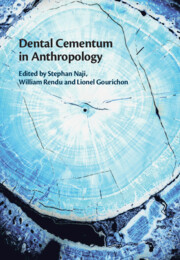Book contents
- Dental Cementum in Anthropology
- Dental Cementum in Anthropology
- Copyright page
- Dedication
- Contents
- Contributors
- Foreword
- Introduction: Cementochronology in Chronobiology
- Part I The Biology of Cementum
- 1 A Brief History of Cemental Annuli Research, with Emphasis upon Anthropological Applications
- 2 Development and Structure of Cementum
- 3 Insights into Cementogenesis from Human Disease and Genetically Engineered Mouse Models
- 4 A Comparative Genetic Analysis of Acellular Cementum
- 5 Pattern of Human Cementum Deposition with a Special Emphasis on Hypercementosis
- 6 Recent Advances on Acellular Cementum Increments Composition Using Synchrotron X-Radiation
- 7 Incremental Elemental Distribution in Chimpanzee Cellular Cementum: Insights from Synchrotron X-Ray Fluorescence and Implications for Life-History Inferences
- 8 Identifying Life-History Events in Dental Cementum: A Literature Review
- Part II Protocols
- Part III Applications
- Index
- Plate Section (PDF Only)
- References
6 - Recent Advances on Acellular Cementum Increments Composition Using Synchrotron X-Radiation
from Part I - The Biology of Cementum
Published online by Cambridge University Press: 20 January 2022
- Dental Cementum in Anthropology
- Dental Cementum in Anthropology
- Copyright page
- Dedication
- Contents
- Contributors
- Foreword
- Introduction: Cementochronology in Chronobiology
- Part I The Biology of Cementum
- 1 A Brief History of Cemental Annuli Research, with Emphasis upon Anthropological Applications
- 2 Development and Structure of Cementum
- 3 Insights into Cementogenesis from Human Disease and Genetically Engineered Mouse Models
- 4 A Comparative Genetic Analysis of Acellular Cementum
- 5 Pattern of Human Cementum Deposition with a Special Emphasis on Hypercementosis
- 6 Recent Advances on Acellular Cementum Increments Composition Using Synchrotron X-Radiation
- 7 Incremental Elemental Distribution in Chimpanzee Cellular Cementum: Insights from Synchrotron X-Ray Fluorescence and Implications for Life-History Inferences
- 8 Identifying Life-History Events in Dental Cementum: A Literature Review
- Part II Protocols
- Part III Applications
- Index
- Plate Section (PDF Only)
- References
Summary
Acellular cementum anchors the root to the alveolar socket via the periodontal ligament and grows in layers continuously throughout life, unlike enamel and dentin. Increments are deposited in a biannual light-dark pattern correlated to age and season at death in transmitted light microscopy. This study investigates the still debated structure of individual acellular increments using x-ray fluorescence and x-ray diffraction mapping with synchrotron radiation microbeams on reindeer, red deer, cattle, and human samples. Results show that Ca or Zn x-ray fluorescent intensities and cAp diffracted intensity reveal cementum band structure. Average crystallographic texture (of cAp nanoplatelets’ orientation and collagen fibril orientations) is constant for each specimen. Microtextural variation is also present across individual bands, demonstrating that the overall collagen fibril orientation undergoes subtle changes with season. Patterns of “feast or famine” and concomitant changes in amount and intensity of PDL loading might produce altered collagen (and cAp) orientations between the “good” and the “bad” seasons for ungulates but maybe not for modern human populations.
- Type
- Chapter
- Information
- Dental Cementum in Anthropology , pp. 110 - 137Publisher: Cambridge University PressPrint publication year: 2022
References
- 1
- Cited by



